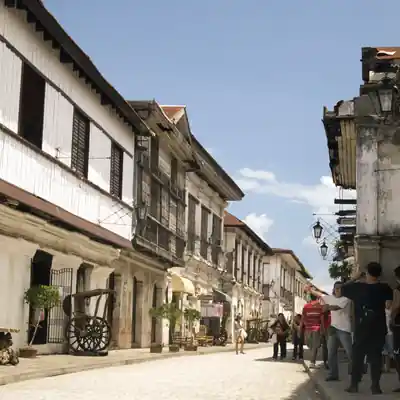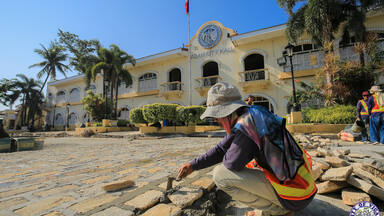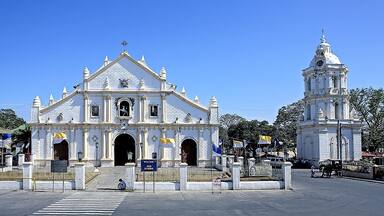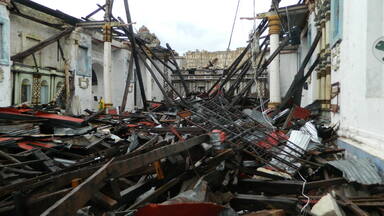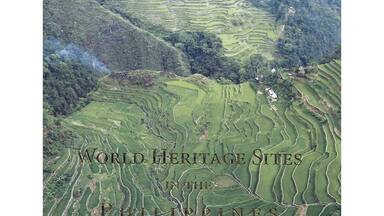Ville historique de Vigan
Historic City of Vigan
Established in the 16th century, Vigan is the best-preserved example of a planned Spanish colonial town in Asia. Its architecture reflects the coming together of cultural elements from elsewhere in the Philippines, from China and from Europe, resulting in a culture and townscape that have no parallel anywhere in East and South-East Asia.
La description est disponible sous licence CC-BY-SA IGO 3.0
Ville historique de Vigan
Vigan est l'exemple le plus intact de ville coloniale espagnole fondée au XVIe siècle en Asie. Son architecture reflète la réunion d'éléments culturels en provenance d'autres régions des Philippines, de Chine et d'Europe, créant une culture unique et un paysage urbain sans équivalent en Extrême-Orient.
La description est disponible sous licence CC-BY-SA IGO 3.0
مدينة فيغان التاريخية
تُعتبَر فيغان أكثر المدن دلالةً على الاستعمار الاسباني، وهي قد أُسِّست في القرن السادس عشر في آسيا. وتعكس هندستها تمازجَ عناصرَ ثقافيّة تختلف مصادرها: من الفيليبين الى الصين وحتى من اوروبا، مبتكرة بذلك ثقافة فريدة ومنظراً طبيعيًّا مُدنيًّا لا مثيل له في آسيا القصوى.
source: UNESCO/CPE
La description est disponible sous licence CC-BY-SA IGO 3.0
维甘历史古城
维甘始建于16世纪,是亚洲保存最完好的西班牙殖民城市。该建筑不仅反映出菲律宾其他地方的建筑风格,而且还融入了中国和欧洲的建筑特色。维甘风光秀美,有丰富的文化底蕴,在东亚和东南亚都是首屈一指的。
source: UNESCO/CPE
La description est disponible sous licence CC-BY-SA IGO 3.0
Исторический город Виган
Основанный в XVI в. Виган – это наиболее хорошо сохранившийся пример спланированного испанского колониального города в Азии. Его архитектура вбирает в себя традиции, свойственные как другим районам на Филиппинах, так и Китаю и Европе. Все это повлияло на местную культуру и облик города, которым нет аналогов нигде на Дальнем Востоке и в Юго-Восточной Азии.
source: UNESCO/CPE
La description est disponible sous licence CC-BY-SA IGO 3.0
Ciudad histórica de Vigan
Fundada en el siglo XVI, la ciudad de Vigan es el ejemplo más fiel e intacto del urbanismo colonial español en Asia. Su arquitectura es un exponente de la confluencia de elementos culturales procedentes de otras regiones de Filipinas, así como de China y Europa. Esa confluencia ha dado por resultado la configuración de un paisaje urbano excepcional y de una cultura sin parangón en todo el Extremo Oriente.
source: UNESCO/CPE
La description est disponible sous licence CC-BY-SA IGO 3.0
古都ビガン
source: NFUAJ
Historische stad Vigan
Source : unesco.nl
Valeur universelle exceptionnelle
Brève synthèse
Vigan est l'exemple le plus intact de ville coloniale espagnole planifiée fondée au XVIe siècle en Asie. Son architecture reflète la réunion d'éléments culturels en provenance d’autre régions des Philippines, de Chine, d'Europe et du Mexique pour créer une culture unique et un paysage sans équivalent en en Asie de l’Est et du Sud-Est. Important centre commercial avant l'ère coloniale, Vigan est située dans le delta de l’Abra, en bordure de la côte nord-ouest de l'île principale de Luzon, dans la province d’Ilocos Sur de l’archipel des Philippines. La superficie totale du bien inscrit est de 17,25 ha. Le plan hispanique traditionnel en damier de la ville s'ouvre sur deux places adjacentes. La Plaza Salcedo représente la partie plus longue d'un espace ouvert en forme de L, et la Plaza de Burgos la plus courte. Les deux places sont dominées par la cathédrale Saint-Paul, le Palais de l'archevêché, l'Hôtel de Ville et le bâtiment du Capitole provincial. Le plan de la ville est conforme au plan quadrillé de la Renaissance décrit dans la Ley de las Indias qui s’applique à toutes les villes nouvelles de l'empire espagnol. Vigan se distingue cependant des villes de l’empire colonial espagnol de la même époque implantées en Amérique latine par son centre historique (que l’on appelle le quartier Mestizo), où la tradition latine est tempérée par de fortes influences chinoises, ilocanos et philippines. Comme son nom l'indique, de riches familles métisses d’origine chinoise et ilocano s’installèrent dans ce quartier. La zone contient l'empreinte historique de la ville entière et se compose d'un total de 233 bâtiments historiques enserrés dans un quadrillage de vingt-cinq rues.
Les structures à deux étages sont construites en briques et en bois, avec un toit à forte pente qui rappelle l'architecture traditionnelle chinoise. Les murs extérieurs de l'étage supérieur sont percés de panneaux vitrés décorés de coquillages Kapis et encadrés de bois qui coulissent pour assurer une meilleure ventilation. La plupart des bâtiments existants ont probablement été construits entre le milieu du XVIIIe siècle et la fin du XIXe siècle. En raison du déclin économique de Vigan en tant que centre économique après la Seconde Guerre mondiale, seuls quelques-uns des bâtiments historiques ont subi une réorganisation interne pour des usages alternatifs. Les marchands et les négociants chinois menaient leurs affaires dans les boutiques, les bureaux et les entrepôts situés au rez-de-chaussée de leur maison, leur habitation se trouvait au niveau supérieur. Outre l’architecture commerciale et résidentielle, Vigan possède un certain nombre de bâtiments publics importants, qui eux aussi montrent des influences multiculturelles.
Vigan est unique en ce qu’elle a conservé l’essentiel de son caractère colonial espagnol, en particulier le plan des rues en damier et son tissu urbain historique. Son importance réside aussi dans la façon dont les différentes influences architecturales se sont imbriquées pour créer un paysage urbain homogène.
Critère (ii): Vigan représente une alliance unique de la conception architecturale et de la construction asiatiques avec les caractéristiques urbanistiques et architecturales coloniales européennes.
Critère (iv) : Vigan est un exemple exceptionnellement intact et bien préservé de ville commerçante européenne en Extrême-Orient
Intégrité
Tous les éléments constitutifs de ses valeurs sont inclus dans le bien. Cela garantit que son importance en tant que ville coloniale hispanique bien planifiée et bien préservée est représentée.
À l'heure actuelle, les principales caractéristiques de la plupart des maisons ancestrales de Vigan sont conservées, bien que quelques-unes de ces maisons soient dans un état de détérioration en raison de la négligence de leurs propriétaires absents.
Authenticité
Vigan a conservé son authenticité dans le plan en damier des rues, le tissu urbain historique et l'utilisation des espaces ouverts.
Les bâtiments historiques ont gardé leur usage traditionnel pour le commerce dans les étages inférieurs et d’habitation pour les propriétaires dans les étages supérieurs. Cependant, très peu de maisons sont restées intactes. Les modifications apportées aux maisons les mieux conservées ont concerné les intérieurs: subdiviser les grandes salles d'habitation pour créer des appartements plus petits, transformer les rez-de-chaussée en espaces pour une utilisation commerciale. Après avoir été complètement réorganisées pour permettre de nouveaux usages, de nombreuses structures ont perdu leur authenticité. Quelques-unes ont été abandonnées, négligées et laissées en état de dégradation. Les matériaux de construction originaux tels que les briques, le bois, les coquillages Kapis et la chaux pour le mortier et le plâtre venaient tous des zones environnantes.
Le manque de matériaux de construction traditionnels tels que le bois et la chaux pour le plâtre et le mortier a conduit à utiliser des matériaux modernes comme le ciment et l’acier galvanisé pour les toitures. La prise de conscience de la nécessité de préserver l'authenticité a considérablement augmenté depuis que le bien a été inscrit. Les pratiques de conservation qui s’étaient développées de façon naturelle au cours des trois derniers siècles, ont désormais été réintroduites, en faisant usage d'une réserve considérable de métiers traditionnels de la construction qui ont survécu.
Eléments requis en matière de protection et de gestion
Le bien fait l’objet d’une protection suffisante grâce aux dispositions législatives locales, à savoir: l'ordonnance n°12, S 1997 délimitant le centre historique et les zones tampons du bien; l'ordonnance n°14 S de 1997 sur les utilisations autorisées dans les zones protégées ; et les ordonnances de protection modifiées ultérieurement en tant qu’ordonnance de la ville n°7, S 2006 établissant les Lignes directrices de conservation de Vigan. Le Conseil de Conservation de Vigan et son groupe de travail technique ont été créés par un décret de 1999 pour élaborer, recommander, évaluer et approuver toute intervention matérielle dans les zones protégées, assurant ainsi une application stricte des Lignes directrices de conservation de Vigan. Le bien est également protégé par les dispositions nationales de protection, juridiques et administratives, existantes, y compris la Loi de la République 10066 de 2009 qui prévoit la protection et la conservation du patrimoine culturel national.
Le développement, la conservation et la gestion durable du bien sont guidés par le Plan directeur de Vigan de 1999, élaboré avec la participation de multiples parties prenantes. Il englobe les aspects matériel, architectural, développement urbain, infrastructurel, juridique, anthropologique, sociologique, environnemental, touristique et économique de Vigan.
Afin de responsabiliser les propriétaires de bâtiments historiques à l’entretien et à la restauration de leurs maisons ancestrales, l'UNESCO et le gouvernement de la Ville de Vigan ont publié le Manuel de conservation pour les propriétaires de patrimoine. Le gouvernement de la Ville a également créé un centre de formation pour relancer l'artisanat de construction traditionnelle.
Vigan est devenue une destination touristique majeure des touristes nationaux depuis son inscription. Bien que le tourisme ne soit pas la principale industrie à Vigan, il a apporté des avantages économiques et sociaux à tous les acteurs de Vigan. En conséquence, le nombre croissant de visiteurs a encouragé la réutilisation des espaces à l'intérieur des maisons ancestrales comme installations d'hébergement, fournisseurs de services pour les visiteurs et points de vente de produits locaux. Un conseil multisectoriel du Tourisme de Vigan a été créé pour aider les autorités de la ville dans la formulation de politiques appropriées et dans le suivi des activités de tourisme et de leur impact sur les valeurs du bien.
Le système de gestion mis en place par les autorités de la Ville de Vigan, le Conseil de Conservation de Vigan (CCV), est un conseil multisectoriel, composé de représentants du gouvernement, de l'église, des universités, des organisations professionnelles, du secteur privé, et d’experts en conservation et de juristes. Le CCV aborde toutes les questions liées au tourisme, y compris la gestion touristique, la promotion de l'artisanat et des produits de l'industrie et d’autres questions. Il traite des problèmes liés aux destinations touristiques dans la Ville de Vigan. Il aborde également les questions environnementales telles que la gestion des déchets résultant du tourisme, en collaboration avec l'agence de la ville concernée et son représentant, Conseil municipal pour l’environnement (Sangguiniang Panlunsod, SP), qui siège au sein du Conseil. Il traite également des questions liées à l'hébergement et aux installations touristiques et d’autres questions. Le Conseil est composé de membres de la communauté afin qu'ils soient conscients des enjeux et des préoccupations liés au tourisme, car ils y sont confrontés eux-mêmes. Ils définissent des solutions à ces problèmes.
Les bâtiments et les espaces ouverts possèdent divers statuts de propriété. Les bâtiments publics appartiennent à différents propriétaires comme le gouvernement provincial, la municipalité et les autorités catholiques. Alors que ceux-ci sont accessibles au public, la majorité des maisons sont des propriétés privées appartenant aux descendants des premiers habitants qui les ont construites. Certaines sont ouvertes au public comme les boutiques de souvenirs, hôtels, cafés, restaurants et autres utilisations. Les autorités de la Ville de Vigan collaborent avec les différents propriétaires d'immeubles dans la Ville par l’intermédiaire du CCV.
Divers programmes et projets ont été mis en œuvre pour atténuer les effets négatifs des changements d’utilisation des bâtiments et de leur modernisation. Parmi les événements importants, on citera la récente publication du Manuel de conservation pour les propriétaires de patrimoine, qui guide les propriétaires dans la réparation et la restauration des maisons historiques de Vigan, et la mise en place de l'école pour la renaissance des matériaux de construction et des systèmes traditionnels (Eskwela Talyer). Cependant, en dépit des efforts majeurs déjà consentis pour la conservation, la protection et la promotion du centre historique, les inquiétudes persistent en raison notamment de la nécessité de disposer immédiatement de matériaux traditionnels et historiques pour les utiliser dans des projets de restauration. La participation dynamique de Eskwela Talyer, ainsi que la participation active des institutions académiques et des organisations traditionnelles de fabricants de matériaux de construction est plus que nécessaire à cet égard.
Mais, surtout, la préservation de la valeur patrimoniale de la ville historique de Vigan bénéficie d’un soutien et d’un appui politiques non partisans. L'ensemble de la communauté de Vigan est conscient de l’importance de cette ville historique et s’est engagé à faire en sorte qu’elle soit maintenue sur le long terme. Les mesures pour la protection, la conservation et la durabilité sont universellement prises en charge et servent de modèles pour la conservation du patrimoine des autres communautés historiques aux Philippines.
Les industries traditionnelles comme la production de saucisses, la Burnay (poterie), le tissage manuel du coton abel, la fabrication de meubles ainsi que la richesse des traditions culturelles immatérielles liées à la foi catholique romaine perdurent jusqu’à aujourd’hui et restent authentiques, contribuant ainsi aux riches traditions de cette ville historique.
